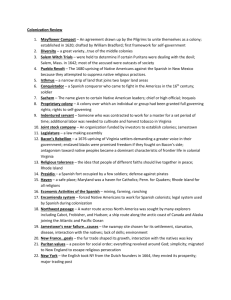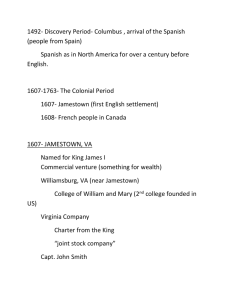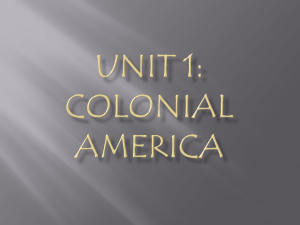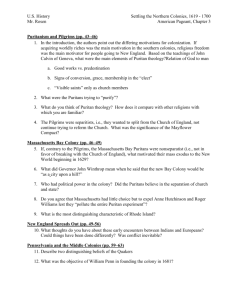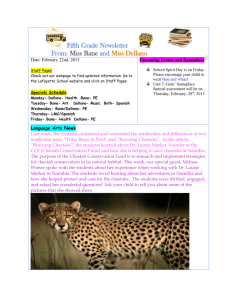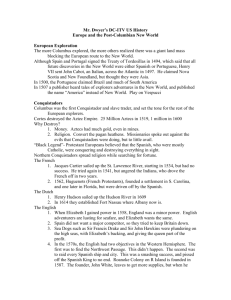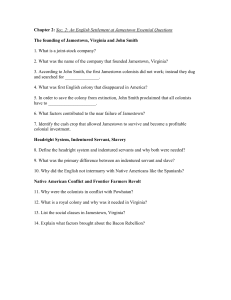united states study questions
advertisement
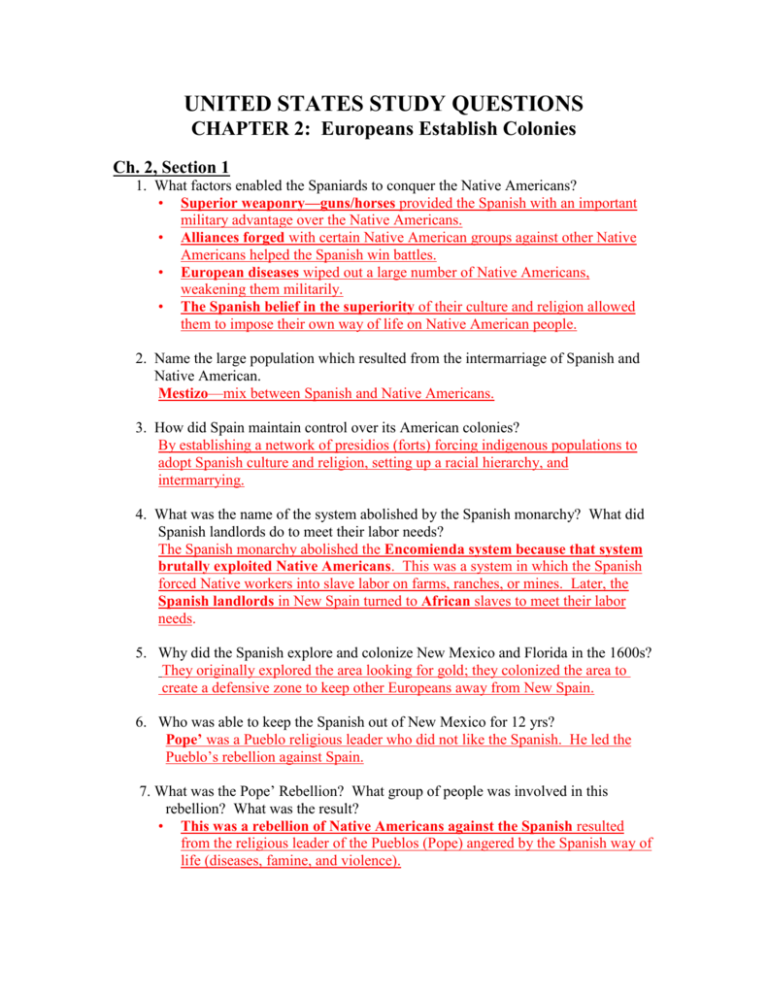
UNITED STATES STUDY QUESTIONS CHAPTER 2: Europeans Establish Colonies Ch. 2, Section 1 1. What factors enabled the Spaniards to conquer the Native Americans? • Superior weaponry—guns/horses provided the Spanish with an important military advantage over the Native Americans. • Alliances forged with certain Native American groups against other Native Americans helped the Spanish win battles. • European diseases wiped out a large number of Native Americans, weakening them militarily. • The Spanish belief in the superiority of their culture and religion allowed them to impose their own way of life on Native American people. 2. Name the large population which resulted from the intermarriage of Spanish and Native American. Mestizo—mix between Spanish and Native Americans. 3. How did Spain maintain control over its American colonies? By establishing a network of presidios (forts) forcing indigenous populations to adopt Spanish culture and religion, setting up a racial hierarchy, and intermarrying. 4. What was the name of the system abolished by the Spanish monarchy? What did Spanish landlords do to meet their labor needs? The Spanish monarchy abolished the Encomienda system because that system brutally exploited Native Americans. This was a system in which the Spanish forced Native workers into slave labor on farms, ranches, or mines. Later, the Spanish landlords in New Spain turned to African slaves to meet their labor needs. 5. Why did the Spanish explore and colonize New Mexico and Florida in the 1600s? They originally explored the area looking for gold; they colonized the area to create a defensive zone to keep other Europeans away from New Spain. 6. Who was able to keep the Spanish out of New Mexico for 12 yrs? Pope’ was a Pueblo religious leader who did not like the Spanish. He led the Pueblo’s rebellion against Spain. 7. What was the Pope’ Rebellion? What group of people was involved in this rebellion? What was the result? • This was a rebellion of Native Americans against the Spanish resulted from the religious leader of the Pueblos (Pope) angered by the Spanish way of life (diseases, famine, and violence). • • • His uprising against the Spanish drove the Spanish out of New Mexico (Santa Fe) for 12 years. Native Americans destroyed Spanish churches (Congregacions) and executed Spanish priests because the settlers had forced the Native Americans to pay tribute to their religious leader. Those who failed to pay tribute or who were caught practicing their native religion were abused physically. The Spanish eventually returned to show greater restraint toward the Pueblos. Ch. 2, Section 2 1. Explain the Northwest Passage. It was a water route to Asia through the cold waters of present day Canada. They probed the eastern coastline of North America from present-day North Carolina to Newfoundland. 2. How did France’s American colonies differ from Spain’s American colonies? Unlike the Spanish colonies, the settlement of New France reflected the beneficial relationship that developed between Native Americans and the French, who required the Native Americans cooperation to carry on the fur trade. 3. Why might good relations with Indians have been important to French traders? The Native Americans caught the plentiful animals and traded the valuable skins with the French. 4. Where was the French colony? Who founded the territory? Quebec, it was the first permanent European (French) settlement in Canada. The French built a fortified trading post in Quebec along the St. Lawrence River in 1608. It was founded by Samuel de Champlain, who traded furs/animal skins with the Native Americans. 5. Why did New France attract few colonists? The dense forests, a relatively harsh climate, and fear of Indian raids made settlement in New France unappealing. Ch. 2, Section 3 1. Explain joint-stock company. What would be the benefit of a joint-stock company? A group of investors who would put their money together to fund trips to the New World with hopes of sharing in the company’s profits and losses from the expected raw materials found. This arrangement would make it possible to fund ventures that were too expensive to be financed by an individual and would also spread the risk among a number of investors. 2. Who was John Smith? John Smith became known as the “savior for the area”. He was a selfproclaimed soldier of fortune, a sea captain, and a poet. He saved Jamestown by encouraging the colonists to farm for survival. With the help of Smith’s leadership, the production of tobacco became a profitable crop for the small English settlement of Jamestown. 3. What did the settlers in Jamestown directed most of their energy toward? They were only interested in finding gold (dig gold, wash gold, load gold, etc). They came to North America to find wealth. They had little interest in promoting the general welfare of the colony. They were ill-prepared for settlement. The first settlers were all men. 4. Explain the original purpose of the Jamestown colony. Why did the settlers fail so miserable on fulfilling that purpose? The first English colonies in North America were set up in the hopes of achieving financial gain (finding gold and other riches) for investors (joint-stock companies). These colonists came to the new world to make a profit for the Virginia Company. Many refused to farm, clean their bodies, and take care of their food causing diseases and malnutrition, etc. 5. What actually made Jamestown into a profitable enterprise? How did it save the colony? Who was responsible for this product? Jamestown finally became productive when they started to produce tobaccobrown gold. Tobacco provided a cash crop that colonists could sell at a profit. John Smith (leader of the colony) helped to encourage the growth of this crop. 6. Explain the Headright system. Headright system—(land ownership) each new arrival received 50 acres of land and another 50 acres for each family member. The Virginia Company would give the land with hopes of having more settlers live in Jamestown. This extra number of settlers would allow for an increase in tobacco production and tobacco profit. 7. What was the purpose of the House of Burgesses? It served as the first representative body in colonial America. It included 2 citizens or burgesses from each of Virginia’s 11 districts. The House of Burgesses began a strong tradition of representative government in the English colonies. 8. How did the government of Virginia differ from the governments of the Spanish and French colonies? Unlike the Spanish and French colonies, colonial Virginia was permitted to establish a representative body, called the House of Burgesses, which could make laws and raise taxes for the settlers. 9. Describe the relationship between settlers and Powhatan people. • The relationship between the English and Native Americans was lukewarm and poor. The English fought the Native Americans and drove them away from Virginia. • As more and more settlers arrived in Jamestown on the frontier, relations between the settlers and the Powhatan people worsened. • The colonist stole land from the Powhatan people, leading to the Powhatan people harassing the settlers by killing the colonist’s livestock and destroying their farms. 10. What is a Royal colony? What was the result of Virginia being a royal colony? • In 1624, King James I revoked the Virginia Company’s charter and made Jamestown a royal colony which meant it became under the direct control of the King. This allowed for more British troops and settlers to come to Virginia and strengthen the colony. It also allowed for them to be present to fight against/conquer the Powhatan people. 11. Who was Nathaniel Bacon? Why did Nathaniel Bacon lead a rebellion against the governor (Berkeley) of Virginia? A 29 year old wealthy planter that came to the settler’s rescue, he raised an army to fight the Native Americans over land. He also protested the Virginia government in defense of poor settlers. Bacon’s Rebellion started because of Nathaniel Bacon’s sympathy with the problems faced by English settlers on the frontier. Bacon led a protest against the governor of Virginia due to the treatment of the poor settlers. Frontiersmen resented being taxed and ruled without their consent by the Virginia governor. It was the favoritism show by Governor Berkeley toward the wealthiest class, the heavy taxes he levied on poorer farmers, and his unwillingness to support farmers’ aggressions against the Native Americans. 12. What was the colony Georgia purpose? Who was it named after and by whom? Georgia was established as a haven for those imprisoned for debt. The colony was named by English philanthropist James Oglethorpe in honor of King George II. 13. Name Oglethorpe’s policies for the colony? Although few debtors actually came, Oglethorpe’s policies included: prohibiting slavery and drinking of rum. Ch. 2, Section 4 1. Who was John Winthrop? John Winthrop was the first leader, governor of Massachusetts Bay Colony and he wanted the colony to be viewed as a model society. 2. What was the meaning of the Puritan concept of a “city upon a hill”? The Puritan’s views and attitudes led them to promote the idea of a “model society” meaning hard work and a good work ethic would lead to rapid growth and success of the New England colony. Every colonist would have the same common goals and lead by example. Also each would be able to worship as they chose. 3. How were the Separatists different from other Puritans? The Puritans wanted to reform the Church of England anything that was of Catholic values in their church. This was due to them being persecuted in England. They traveled to the New England territory in the new world. Separatists (Puritans who broke away from the Anglican Church), known as Pilgrims. They felt it was impossible to reform to the Church of England from within so they wanted to separate from the Anglican Church. 4. Why did the Puritans leave England? The Puritans wanted to escape religious persecution in England. Some puritans, such as the Pilgrims left to break away from the Church of England. Others left to escape political, social, and economic turmoil. The Puritans believed the Church of England needed to be reform—purified. They ended up leaving England and settled in colonial America. In the beginning the Massachusetts Bay Colony was the Puritans hope to be able to worship as they chose and to create a model society. 5. What was the purpose of the Mayflower Compact? A civil type of government that pledged loyalty to the King. The purpose of the government in America would be to frame “just and equal laws” for the general good of the colony. Later this document became the landmark of American democratic government. 6. Why was the government established by Puritans in the Massachusetts Bay Colony unique? It was a representative form of government (in which only stockholders/landholders, all adult males who belonged to the Puritan church could vote), featuring an assembly, a governor, and a deputy governor who were only elected by the colony’s Puritan men. 7. Who is Roger Williams? What caused conflict between the Puritans and Roger Williams? What resulted in the conflict? Roger Williams was a preacher that spoke out against some of the religious practices in the Massachusetts Bay Colony. He believed everyone should be free to worship. He also believed the Puritan’s had no right to the land unless they purchased it from the Native Americans. The Puritan leaders ordered that Williams be arrested. Williams left and founded Providence, Rhode Island; a haven for religious dissenters where religious freedom is guaranteed. 8. What two principles of did Providence guarantee that Massachusetts Bay did not? Providence guaranteed: separation of the church and state and religious freedom. 9. Who was Anne Hutchinson? What were the cause and the result of the conflict between the Puritan church and Anne Hutchinson? A separatist who spoke out against the Puritan beliefs by stating one could “interpret the bible for themselves”. This encouraged many people to reframe from attending daily church gatherings. She was banished from the Massachusetts Bay Colony, so she settled in Rhode Island and founded the town of Portsmouth. 10. What caused the conflict between Pequot and the Puritans? What was the result of the conflict? The colonist wanted to keep moving west. Their first conflict arose with the Pequot nation. The Pequot people lived east of the Connecticut River. The Pequot war results in all of the following: 1-virtual elimination of the Pequot nation (5/400 lived) 2-extreme violence on the part of English colonists 3-cooperation between English colonists and Native American allies 4-resulted in victory for the puritans 11. Why did Wampanoag chief Metacom organize an alliance? The Wampanoag Chief Metacom organized an alliance because they had very different views, religious beliefs, and interpretations of land treaties from the Puritans. These negative views were displayed on both sides (Wampanoag and Puritans). 12. What caused the conflict King Phillip’s War (between the Wampanoag and the Puritans)? What was the result of the conflict? Wampanoag and Puritans had very different views: the influx of settlers as well as the Puritan intolerance for religious dissent led to the destruction of the Wampanoag way of life. They fought back by starting King Phillip’s war in 1675; Chief Metacom led several tribes in King Phillip’s war. This war resulted in colonial victory (due to surrender because of Native American casualties, European diseases, and famine) and end of Native American power in southeastern New England. Ch. 2, Section 5 1. What was the name of the colony organized by the Dutch West India Company? In 1621, Dutch government granted the newly formed Dutch West India company permission to colonize New Netherland and expand the thriving fur trade. The Dutch built New Amsterdam at the tip of Manhattan to guard the mouth of the Hudson River, along which they settled. 2. What were some important characteristics of the colony of New Netherland? Ethnic diversity and religious tolerance resulted in generally good relations with the Native Americans. New Netherland did not have elected assemblies. 3. Explain how New York got its name? In 1664, King Charles II seized control of the New Netherland colony (which included New Amsterdam) and granted all the land from Delaware Bay to the Connecticut River to his brother James (Duke of York). This was done due to the Dutch’s unfriendly relationship with the English King who took over the colony (he was blamed for separating the northern and southern colonies). 4. How was New Jersey formed? New Jersey was formed due to the Duke of York giving a portion of the land to two of his friends naming the territory New Jersey for the British island of Jersey. New Jersey was the southern part of New York. 5. Who was William Penn? William Penn started the colony of Pennsylvania. He committed himself to the “society of friends, or Quakers”; a Protestant sect who’s religious and social beliefs were radical for the times. 6. How did the Quaker beliefs compare to the Puritan beliefs? • Quaker believed in an “inner light” and respect for self-conscience; practiced freedom of speech, religious tolerance allowed, and no ministers. • Puritans purify the Anglican Church and no religious tolerance; build a model society and had ministers. • Both groups believed in a personal experience with god 7. What were some important characteristics of the colony of Pennsylvania? The idea of equality, cooperation, and religious tolerance; they held services without formal openings allowing any other person to speak as the spirit moved them. Dress plainly, refused to defer to any person of rank; refused to serve in the military. 8. Explain why William Penn saw his colony as a “holy experiment”? Penn saw his colony as a “holy experiment” because it was a place without a land owning aristocracy. Penn guaranteed every adult male settler 50 acres of land and the right to vote. His plan for government called for a representative assembly and freedom of religion. 9. How did Penn’s attitude and actions toward the Native Americans differ from those of the Puritans? Very friendly relations with the Native Americans. Penn desired to gain respect and friendship (Penn/Native Americans). He paid the Native Americans for land; Regulated trade with the Native Americans; Established a court to settle differences for more than 50 years. All resulted in no major conflicts with the Native Americans. Penn sought to cultivate peace with the Native Americans. 10. Explain the half-way covenant as it affected the Puritan church. It established partial membership in the Puritan church for the children and grandchildren of full members regardless of any conversion experience. 11. What were the underlying causes of the Salem witch hunts in 1692? The strict limitations of women’s roles, combined with social tensions. The strained relationship with Native Americans and religious fanaticism lay behind the witch hunts. 12. What factors led to the witchcraft trials in Salem? Explain the Salem Witchcraft Trials. The Salem girls accusing Tituba (West Indian woman) of practicing witchcraft. The constant fear of Native American attacks encouraged preoccupation with violence and death. These accusations drew a great deal of attention and sparked widespread hysteria.
